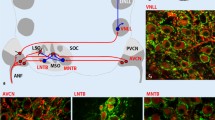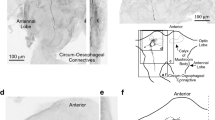Summary
-
1.
The structure and function of an auditory giant neuron in the CNS of the thoracic and head ganglia of the bush cricketDecticus verrucivorus are described.
-
2.
The neuron extends from the abdomen to the supraesophageal ganglion and has several branches, mainly directed toward the midline, in each ganglion of the central nervous system.
-
3.
Dendritic branches of the neuron lie in the prothoracic ganglion; the branches in the other ganglia are probably chiefly presynaptic (information-transmitting) structures, with no morphological differences visible by the light microscope.
-
4.
The neuron shows strong habituation. It reacts tonically only to some of the chirps at the beginning of the species-specific song; later it reacts in an unspecific way or not at all to the song. In the habituated condition the neuron reacts with phasic on-responses to sound signals in the frequency range of 10–40 kHz. Low-frequency sound and vibration stimuli produce inhibitory influences on the activity of the neuron.
-
5.
The response of the neuron is unchanged along the axon stem within the thoracic and the head region of the CNS.
-
6.
The cell is strongly excited on stimulation with air puffs; under these conditions responses to airborne-sound signals can be masked. The receptors responding to air puffs are the low-frequency-sound receptors and middle range-frequency-sound receptors in the ipsilateral tympanal organ.
Similar content being viewed by others
References
Bacon, J.P., Altman, J.S.: A silver intensification method for cobalt-filled neurons in whole mount preparations. Brain Res.138, 359–363 (1977)
Čokl, A., Kalmring, K., Wittig, H.: The responses of auditory ventral-cord neurons ofLocusta migratoria to vibration stimuli. J. Comp. Physiol.120, 161–172 (1977)
Elsner, N., Popov, A.V.: Neuroethology of acoustic communication. Adv. Insect Physiol.13, 229–355 (1978)
Hughes, G.M.: Neuronal pathways in the insect nervous system. In: The physiology of the insect nervous system. Treherne, J.E., Beament, J.W.L. (eds.), pp 79–112. New York: Academic Press 1965
Kalmring, K.: The afferent auditory pathway in the ventral cord ofLocusta migratoria (Acrididae). I. Synaptic connectivity and information processing among the auditory neurons of the ventral cord. J. Comp. Physiol.104, 103–141 (1975)
Kalmring, K., Kühne, R., Moysich, F.: The auditory pathway in the ventral cord of the migratory locust (Locusta migratoria): Response transmission in the axons. J. Comp. Physiol.126, 25–33 (1978a)
Kalmring, K., Lewis, B., Eichendorf, A.: The physiological characteristics of the primary sensory neurons of the complex tibial organ ofDecticus verrucivorus L. (Orthoptera, Tettigoniidea). J. Comp. Physiol.127, 109–121 (1978b)
Kühne, R.: Der Vibrationssinn der WanderheuschreckeLocusta migratoria: Elektrophysiologischer Vergleich von Rezeptor- und Bauchmarkneuronen. Diplomarbeit, Bochum (1977)
McKay, J.M.: The auditory system ofHomorocoryphus (Tettigoniidea, Orthoptera). J. Exp. Biol.51, 787–802 (1969)
McKay, J.M.: Central control of an insect sensory neuron. J. Exp. Biol.53, 137–145 (1970)
Michelsen, A., Larsen, O.N.: Biophysics of the ensiferan ear. I. Tympanal vibrations in bushcrickets (Tettigoniidae), studied with laser vibrometry. J. Comp. Physiol.123, 193–203 (1978)
Rehbein, H.G.: Auditory neurons in the ventral cord of the locust: Morphological and functional properties. J. Comp. Physiol.110, 233–250 (1976)
Rehbein, H.G., Kalmring, K., Römer, H.: Structure and function of acoustic neurons in the thoracic ventral nerve cord ofLocusta migratoria (Acrididae). J. Comp. Physiol.95, 263–280 (1974)
Rheinlaender, J., Kalmring, K.: Die afferente Hörbahn im Bereich des Zentralnervensystems vonDecticus verrucivorus (Tettigoniidae). J. Comp. Physiol.85, 361–410 (1973)
Römer, H.: Statistic analysis of the response pattern as a method for identification of acoustic neurons in katydids. In: “Mechanoreception”. Abh. Rhein.-Westf. Akad. Wiss.53, 325–329 (1974)
Suga, N.: Central mechanism of hearing and sound localization in insects. J. Insect Physiol.9, 867–873 (1963)
Suga, N., Katsuki, Y.: Central mechanism of hearing in insects. J. Exp. Biol.38, 545–558 (1961)
Author information
Authors and Affiliations
Additional information
The work was supported by the Deutsche Forschungsgemeinschaft, as part of the program Sonderforschungsbereich 114 (Bionach) and as part of the program “Neurale Mechanismen des Verhaltens” (Ka 498/1)
We thank Dr. Brian Lewis for critical reading of the manuscript. We are also grateful for technical help to Mrs. I. Klotz and Mrs. A. Scheiding, and to L. Schillak.
Rights and permissions
About this article
Cite this article
Kalmring, K., Rehbein, H. & Kühne, R. An auditory giant neuron in the ventral cord ofDecticus verrucivorus (Tettigoniidae). J. Comp. Physiol. 132, 225–234 (1979). https://doi.org/10.1007/BF00614494
Accepted:
Issue Date:
DOI: https://doi.org/10.1007/BF00614494




